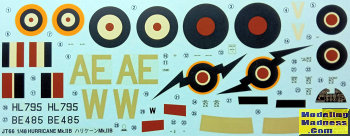
Hasegawa 1/48 Hurricane Mk.IIB
| KIT #: | 09066 |
| PRICE: | Around €25 in 2005 |
| DECALS: | Two options |
| REVIEWER: | Spiros Pendedekas |
| NOTES: |

| HISTORY |
The Hurricane Mk.IIB first took to the air in June 1940 and was aimed at the
Hurricane’s effectiveness in the ground attack role. It featured the improved
Merlin XX engine of the Mk.IIA, a new and slightly longer propeller spinner, and
4 additional wing-mounted .303 in (7.7 mm) Browning machine guns, for a total of
12 guns. The first aircraft were built in February 1941 as Mk.IIA, renamed to
Mk.IIB after April, for a total of 3,050 built to November 1942. For use in
North Africa the plane was fitted with a Vokes dust filter and the pilots were
issued with a desert survival kit, including a bottle of water behind the
cockpit.
| THE KIT |
 Hasegawa
came in 1997 with their very good quarter scale Hurricanes, covering every
variant, with the kits engineered in such a way as to use as many common sprues
as possible, a typical Hasegawa trend. The specific version is the 1999 Mk.IIB,
bought in 2005 from a (sadly now permanently closed) Athens hobby shop.
Hasegawa
came in 1997 with their very good quarter scale Hurricanes, covering every
variant, with the kits engineered in such a way as to use as many common sprues
as possible, a typical Hasegawa trend. The specific version is the 1999 Mk.IIB,
bought in 2005 from a (sadly now permanently closed) Athens hobby shop.
The kit comes in the typical excellent Hasegawa medium sized top opening box,
featuring a superlative Koike Shigeo box art of two 274 Sq RAF tropicalized
Hurricanes flying over the North African desert.
Upon opening the box, I was greeted with 97 medium gray styrene parts, arranged
in 12 sprues of various sizes, all bagged together, meaning potential scratches.
Molding is superb with no flash at all. A small number of ejector pin marks were
noted, with the ones practically unhidden lying in the main gear bay, the inner
tire walls and the underside of the exhausts.
Panel lines are recessed all over and very well done. Some raised rivets are
molded onto the top of the wing panels where the guns reside. Fabric
representation, an essential aspect of every Hurricane kit, is also very well
done.
Cockpit is sufficiently represented with all basic elements, including a number
of levers found at the real plane. The side frame tubing is also well done. The
instrument panel has nice raised detail, which can either be painted or the nice
instrument decal can be used to succumb onto it.
Landing gear and bays are also finely represented, catching the particular busy
looks of the real thing and the same can be said for the radiator assembly. The
fishtail exhaust pipes look good, as does the one piece prop, with the famous
polycap having to be trapped in the spinner. Two carburettor intakes are
provided, normal and tropicalized.
Clear parts are superbly molded and crystal clear. Instructions come to the
usual excellent Hasegawa pamphlet style, including a short history of the type,
a parts diagram, with the straightforward construction spread in 10 concise
steps, with full color callouts given throughout. Three b/w pics of a completed
model are also included.
 Two RAF
schemes are provided, for a 402 (Canadian) Squadron and a 274 Squadron bird, the
latter being tropical. Decals, though excellently printed and looking in good
condition, have their white areas represented as ivory.
Two RAF
schemes are provided, for a 402 (Canadian) Squadron and a 274 Squadron bird, the
latter being tropical. Decals, though excellently printed and looking in good
condition, have their white areas represented as ivory.
Instructions want you to first assemble the cockpit and trap it between the
fuselage halves, followed by the front engine cowling. The wings, including the
main gear bays, are then assembled and attached, followed by the tail planes and
the correct, for the version you build, carburettor intake.
Landing gear is next, followed by the radiator, bombs installation and fitting
of the wing leading edges gun sections, the landing and tip lights and other
small bits.
The propeller is finally assembled and attached, together with the exhausts, the
glare shields (only for the non tropicalized version), the antenna mast, the
canopy and a couple of other tiny bits, ending a seemingly uncomplicated and
pleasant construction.
| CONCLUSIONS |
Though at areas superseded by the newer, more
detailed Airfix offering, this looks to be still a very good kit of the iconic
Hawker Hurricane. Molding is superb, general shapes look correct, panel lines
are nicely engraved, details at key areas are sufficient, transparencies are
excellent, as are the instructions. Decals, though excellently printed, feature
the “ivorizing white” Hasegawa phenomenon of the past. The build itself looks
nice and uncomplex (something less and less common with today’s wonder kits) and
fit is said to be very good.
If you have one in your stash or come across one, it is a kit worth tackling.
Happy modeling!
Spiros Pendedekas
Decenber 2022
Copyright ModelingMadness.com. All rights reserved. No reproduction in part or in whole without express permission.
If you would like your product reviewed fairly and fairly quickly, please contact the editor or see other details in the Note to Contributors.